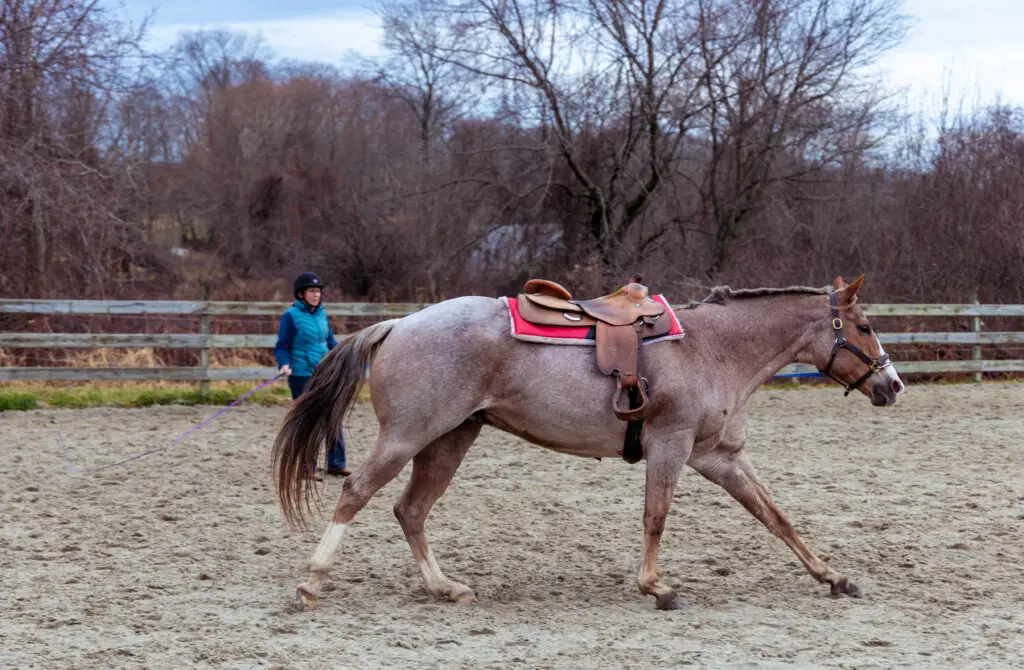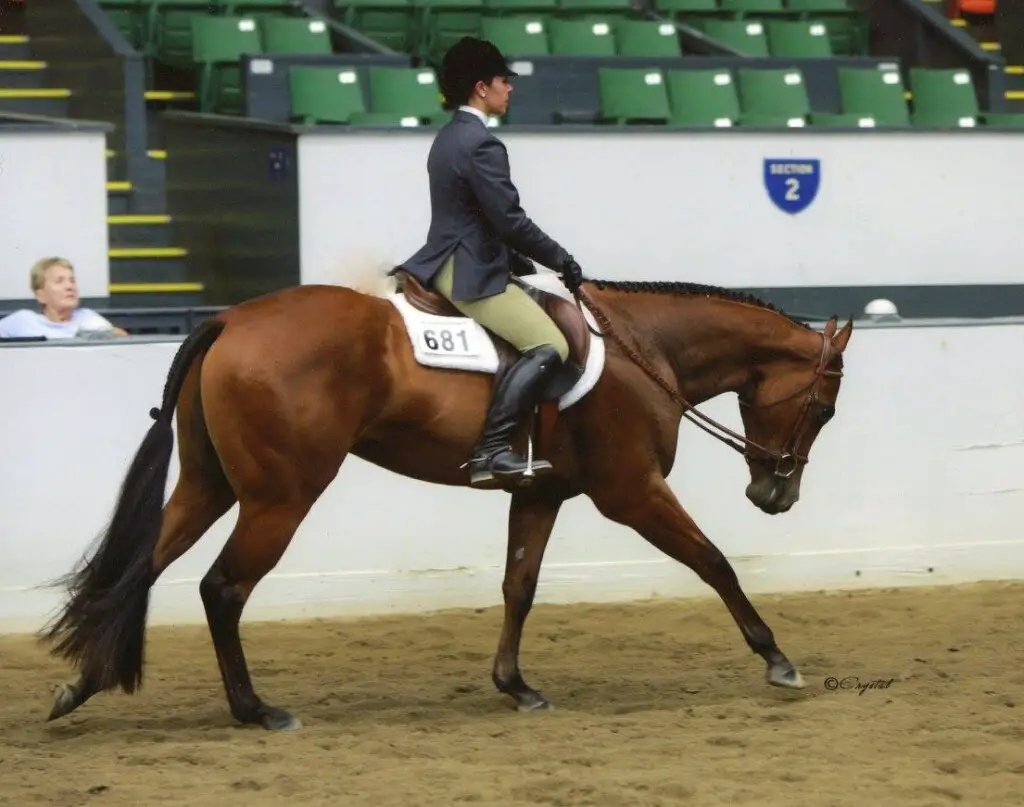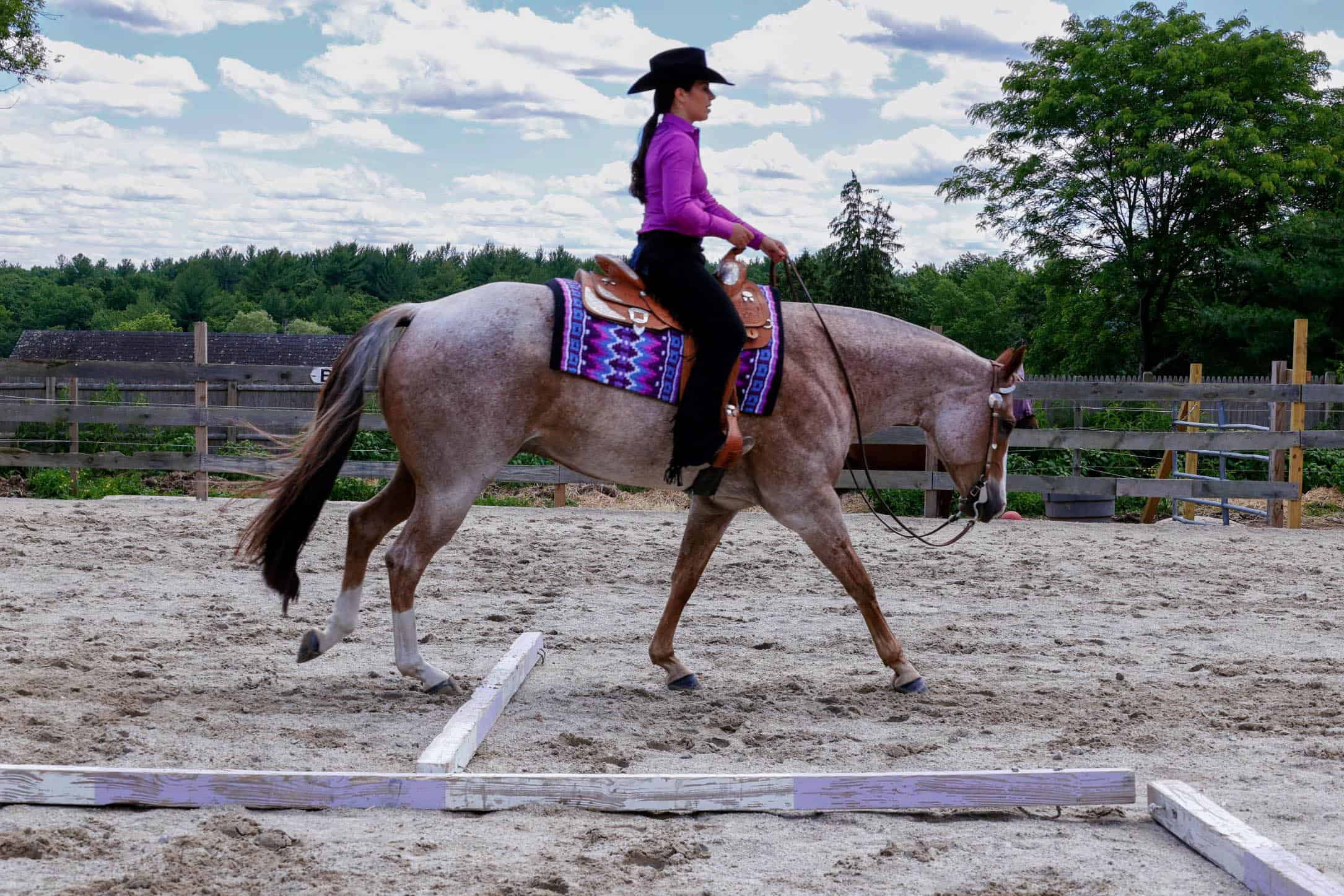Learning how to ride and starting to canter? Feeling a little overwhelmed by all the instructions and pieces to manage while trying to canter? If you’re trying to master how to sit, control your body, steer the horse, balance and get the correct lead at the same time, don’t sweat it!
In this complete guide to understanding your horse’s leads we’ll break down what it all means! You’ll learn about how horses canter and why leads are important! Plus, you’ll find helpful tips for practicing your canter leads!
What Is A Horse’s Lead?
Let’s start with the basics. A canter is a three beat gait in which the horse first places their outside hind leg on the ground first. Followed by the inside hind and outside front leg simultaneously and lastly the inside front leg. The inside front leg extends out in front of the horse further than the other legs. This is known as the lead a horse is on.
The Horse can be on the correct lead if following this sequence above. If the horse does this sequence with the inside hind landing first and the outside hind and inside front together followed by the outside front leg extending the furthest, they are on the incorrect lead or counter canter.
For more information on the terms used in this article such as canter, lope, lead, gait, etc. Check out this guide to understanding horse terminology!
Identifying Leads From The Ground
An easy way to learn and understand the correct lead at the canter is to watch from the ground. If you’re learning to canter and feeling confused, ask your instructor to let you watch another student canter. Or, see if the instructor will put the horse on a lunge line so you can watch the horse canter before you get on. Maybe your instructor will even get on and demonstrate.
If your instructor agrees to help you learn about canter leads from the ground have them put some colored leg wraps on the horse. For example, put one color on the right front leg and a different color on the left front leg. This way your instructor can help you identify incorrect or correct leads by watching for which color is extending the furthest.

Identifying Leads Under Saddle
There are a couple of ways to determine which lead your horse is on while under saddle. The first and most obvious option is to look down at the horse’s shoulders to see which one is leading. Similar to watching the horse’s shoulders to check for the correct diagonal at the trot. This takes a bit of practice as you’ll need to stay balanced in the saddle and not lean forward to stare at your horse’s shoulder for a long time. You should try to glance quickly but long enough to see what’s going on. It’s like driving a car on the highway and changing lanes. You need to look quickly before moving to another lane but you also need to look thoroughly to be sure another car isn’t coming.
The next way to tell if you’re on the correct lead while loping or cantering your horse is by feel. If the canter feels balanced around turns there’s a good chance you are on the right lead. If the canter feels disjointed, uncomfortable and you are having a hard time steering, there’s a good chance you’re on the wrong lead.
You can also pay attention to what you feel the horse doing underneath you. For example, when you feel the horse push off from behind, which side do are they pushing from? If you feel the horse’s hips moving slightly to the inside of the arena and their nose is also tipped slightly in the direction they are traveling, you should be on the correct lead.
It can be difficult to develop the feel of the correct lead if you haven’t cantered or loped many times. Learning to sit to the canter, stay in rhythm and ride a balanced canter is important. When the horse and rider are unbalanced it may feel chaotic no matter which lead you’re riding on.
Picking Up The Correct Lead
Once you’re comfortable sitting to the canter your trainer will have you start to cue the horse for the canter or lope yourself. Often times beginners learn how to sit to the canter while on a lunge line and the instructor cues the horse.
The first time you ask the horse to canter yourself, your instructor may keep you on a lunge line and help you give the cue by guiding the horse’s nose and kissing or clucking. This way the horse will associate your cue with what your instructor intends for you to do. Often times beginner riders have a difficult time staying coordinated and balanced while asking the horse for something new. This can lead to confusion on the horse’s part and as a result he may not go at all.
In order to achieve the correct lead, the rider needs to first position the horse or set him up in the correct way. Start by gently guiding your horse onto a circle or along the rail but with his nose slightly tipped to the inside. Don’t pull hard on the inside rein to achieve this or your horse will just bend their neck into what I like to call a pretzel. Keeping the horse’s body straight is important. Use a little bit of inside leg to keep the horse out on the rail or out on your circle by gently squeezing near the girth. Don’t let your inside leg slide back and try not to tip forward. This will cause you to pick up the incorrect lead.
Next, slide your outside leg back behind the girth a couple of inches before squeezing your leg to ask for the canter. Think about pushing the horse’s hips towards the center of the arena in order to get a clean lope departure. This is because the outside hind leg needs to step under the horse’s body and forward is it is the first in the lope sequence.
As you cue the horse for the correct lead, try to sit in the very center of your saddle and sit straight but don’t tense up. Let your inside hip lift up slightly to allow the horse’s rib cage to move laterally towards the inside. And, remember to keep your heels down!
Ways To Practicing Leads At The Lope And Canter
One of the best ways to practice picking up the correct lead at the canter is to do a lot of transitions. Learning how to give your horse the cue correctly will help ensure that you are able to pick up the correct lead and stay balanced. You’ll need to be careful not to over do it because if you ask the horse incorrectly too many times in one session you will inadvertently teach them not to pick up the correct lead. As a beginner this should be reserved for practicing with your instructors supervision in a lesson.
Start by asking your horse to canter on the rail, and canter about half way around. For example from letter B to letter E. If you begin the canter at letter B, start to ask your horse to stop or break to the trot just before letter E. Bring the horse back down to the walk and ask for the canter again. Take your time and set up correctly without rushing.

Another variation is to break down to a sitting trot or jog instead of a walk which some horse and rider combinations find easier. However, if your horse has a jarring trot and it is difficult to sit and balance, you should pick the canter up from a walk. While it’s important to be able to do transitions between different gaits and within gaits, it’s also important to stay balanced. As a beginner, your priority is safety. The rest will come with time. The last thing you want is a bouncy, fast trot that causes you to lose your balance right before you pick up the canter. Then you’ll struggle with the canter too!
You can also practice this exercise is by forming a large figure 8 using the entire arena. The benefit of traveling through the center is that you can change directions and ask for the other canter lead. When you cross X ask your horse to walk, you can either switch aids and ask for the opposite lead and change directions or you can pick up the same lead you were on and make a circle. It’s good to practice both ways and eventually you can use this exercise to learn how to counter canter.
Changing Leads At The Canter Or Lope
While it may seem intimidating, changing leads at the canter can be quite simple and straight forward. If you are loping on the left lead and want to change directions and track right, you have three choices. Option one is a simple lead change, option two is a flying lead change and option three is a counter-lope. So what do these terms mean anyway?
Simple Lead Changes
A simple lead change is the best way for beginners to learn how to change leads. As mentioned in the section above about ways to practice getting the correct lead, all you need to do is break from the canter or lope to a walk or trot. Start by cantering on one lead, ask the horse to walk or trot and then cue the horse for the opposite lead. If you can pick up the canter yourself and stop the horse yourself, you can do a simple lead change!
Make sure you can stay balanced during the transition before you start trying to do simple lead changes. If you’re uncomfortable with starting and stopping or lose your balance during the transition, don’t overcomplicate your ride by having to change cues for another lead. You should master your transitions first!
Flying Lead Changes
You’ve probably heard this term before but you may not have seen a flying lead change. Or, if you did, you may not have recognized it. A flying lead change is when the horse changes leads in the air without breaking from the canter or lope. In this article we won’t discuss how to ride a flying lead change is it is not a beginner exercise. In fact, you should not attempt a flying lead change without first mastering many other skills and help from your instructor.
However, horses of all ages including foals can change leads with cantering through a paddock without stopping!
Counter-Canter and Counter-Lope
So, we established earlier in this article that a counter canter or counter lope is when the rider intentionally rides the horse on the incorrect lead.
You may be wondering, why the heck anyone would want to do that? Well, lots of reasons!
Counter cantering a horse correctly can help them learn to use their back correctly, lift their shoulders and engage their hindquarters. Many trainers use this exercise as a way of making horses stronger and more balanced. It can also help reinforce following the rider’s cues. To some horses, cantering on the incorrect lead may feel uncomfortable and they may be hesitant until they learn to balance.
Counter cantering can also be a useful tool in teaching horses body control which is a necessary step for learning higher level movements like flying lead changes.
This is another exercise that your instructor will likely wait to have you try until you have become confident and secure at the canter.
I hope you found this article helpful! If you did, please share it!
For more riding tips, check out these related articles!
How To Pick Up The Correct Diagonal At The Trot
8 Neck Reining Tips For Beginner Riders13 Beginner Friendly Riding Exercises To Improve Steering
The Benefits Of Riding Bareback And Tips To Get Started
12 Mounted Horseback Riding Stretches To Do When You Ride

